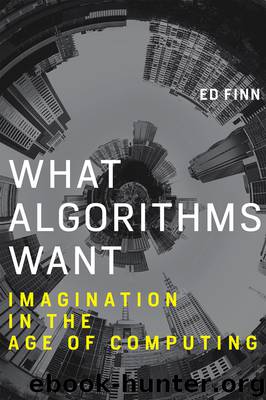What Algorithms Want: Imagination in the Age of Computing (MIT Press) by Ed Finn

Author:Ed Finn [Finn, Ed]
Language: eng
Format: mobi
Tags: apps, Apple, Netflix, coding, hybrid authorship, Bitcoin, culture, new media, search bars
Publisher: The MIT Press
Published: 2017-03-06T05:00:00+00:00
Figure 4.1 Cow Clicker screenshot.
For Bogost, the heart of this critique of the social gaming phenomenon and the social networks it relies on is another foundation-stone in the philosophy of technology, Martin Heidegger’s notion of enframing. In very simple terms, Heidegger argued that technologies (and our social world in general) tend to nudge us into certain modes of thinking about what is possible and what can be revealed about the universe. We see a hammer and we think about what we can hammer with it; but a hammer could also be used to open a bottle, to prop open a door, to hold down papers on a windy day.
In Unit Operations, Bogost describes how social networks encourage modes of enframing by explicitly designing representations of social relationships and tools for manipulating them: “In LinkedIn introducing one business associate to another suddenly becomes a formal unit operation: a set of software interactions that enable bigger professional networks while fixing users’ individual experiences.”15 Cow Clicker takes this enframing to a logically absurd conclusion, allowing players to accumulate extra points when friends “click on your clicks,” formalizing the meaningless action of clicking on a cow. In Bogost’s terms, the unit operation is evacuated of almost all real content, leaving only the satirical digital cow behind, while the network infrastructure, the procedural operations of an addictive social game, remain highly visible. The way that Bogost’s experiment spiraled out of control reflects the ongoing debate about technicity launched by philosophers like Heidegger and Simondon, but now played out in status updates and social games. As users grapple with the intellectual and emotional consequences of enframing, a battle for meaning emerges. The runaway semiotics of Cow Clicker signal that this is satire and sincere pursuit, game and gulag all at once.
Bogost’s critique of these modes of enframing explores the troubling intersection of social engagement, personal compulsion, and interactive design. Cow Clicker is a bad game on multiple levels: its design is deliberately poor and uninteresting; it explicitly aims to waste its players’ time through arbitrary six-hour deadlines; it shamelessly leverages their social networks to expand its viral reach; it tempts them into spending real money on satirical “mooney,” leading one commenter to note: “What fascinates me is the fact that the more money you make from this, the more depressed you are going to feel. I like that, I think it’s funny.”16 But Cow Clicker is not just a game—it satirizes a much deeper form of evolving cultural relationship, one that has blossomed with the age of smartphones and ubiquitous computing into a new kind of systemic colonization of the margins. Like FarmVille, Cow Clicker calls attention to a series of cultural transactions that blur the distinctions between temporal, cultural, and financial units of value, creating systems of algorithmic arbitrage that extract attention and revenue from spaces of “play.” As media scholar McKenzie Wark polemically describes the core arrangement on Facebook: “The power of the vectoral class [in this case, Zynga and Facebook] retreats from direct ownership of the cultural product but consolidates around the control of the vector.
Download
This site does not store any files on its server. We only index and link to content provided by other sites. Please contact the content providers to delete copyright contents if any and email us, we'll remove relevant links or contents immediately.
Deep Learning with Python by François Chollet(12571)
Hello! Python by Anthony Briggs(9916)
OCA Java SE 8 Programmer I Certification Guide by Mala Gupta(9796)
The Mikado Method by Ola Ellnestam Daniel Brolund(9779)
Dependency Injection in .NET by Mark Seemann(9340)
Algorithms of the Intelligent Web by Haralambos Marmanis;Dmitry Babenko(8300)
Test-Driven iOS Development with Swift 4 by Dominik Hauser(7763)
Grails in Action by Glen Smith Peter Ledbrook(7696)
The Well-Grounded Java Developer by Benjamin J. Evans Martijn Verburg(7557)
Becoming a Dynamics 365 Finance and Supply Chain Solution Architect by Brent Dawson(7087)
Microservices with Go by Alexander Shuiskov(6856)
Practical Design Patterns for Java Developers by Miroslav Wengner(6775)
Test Automation Engineering Handbook by Manikandan Sambamurthy(6714)
Secrets of the JavaScript Ninja by John Resig Bear Bibeault(6419)
Angular Projects - Third Edition by Aristeidis Bampakos(6123)
The Art of Crafting User Stories by The Art of Crafting User Stories(5649)
NetSuite for Consultants - Second Edition by Peter Ries(5583)
Demystifying Cryptography with OpenSSL 3.0 by Alexei Khlebnikov(5389)
Kotlin in Action by Dmitry Jemerov(5066)
